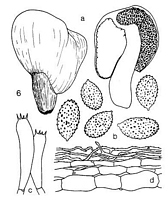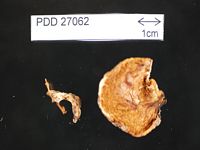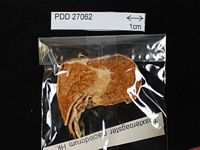|
 Cortinarius pisciodorus Cortinarius pisciodorus
SynonymsThaxterogaster pisciodorus
BiostatusPresent in region - Indigenous. Endemic
Images (click to enlarge)
Caption: Thaxterogaster
pisciodorum Hk. sp.n. (type): a. fruitingbodies
b. spores. c. basidia. d. cuticle. | 
Caption: Dried type specimen
Owner: Herb PDD | 
Caption: Dried type specimen
Owner: Herb PDD |
Article: Horak, E. (1973). Fungi Agaricini Novazelandiae I-V. Beihefte zur Nova Hedwigia 43: 200 p.
Description: Gastrocarp
30-55 x 30-50 mm, hemispherical or ovoid when young, later becoming pear-shaped,
margin of peridium dehiscent from stipe and exposing gleba at maturity, dark
brown, yellow towards the margin, viscid, smooth, without conspicuous veil remnants,
peridium near apex about 4 mm thick. Gleba loculate, chambers up to 3 mm diam.,
irregularly arranged, rust brown to argillaceous. Stipe 35-70 x 10-15 mm, cylindrical,
attenuated towards the apex (columella) and extending into the peridium, gleba
around lower parts of columella partly dehiscent, white, becoming brown, dry,
smooth, without veil remnants. Context orange brown at the base of stipe, dark
brown in the peridium. Odor and taste unpleasant, like rotten fish or burnt
horn. Chemical reactions on peridium unknown.
Spores 11-13.5 x 7-8 µm, elliptic to ovoid,
verrucose, mostly axially symmetric but frequently also bilaterally symmetric,
germ pore lacking, ferruginous. Basidia 36-50 x 10-12 µm, 4-spored. Cystidia
absent. Epicutis consisting of interwoven, repent, slightly gelatinised hyphae
(2-6 µm diam.), encrusted with brown pigment, membrane thin-walled; hyphae of
subcutis short-cylindric, 10-20 µm diam., clamp connections rare but present.
Habitat: On
ground under Nothofagus cliffortioides and N. solandri. New Zealand.
Notes: This
species is recognised by its dark brown and yellow colouration, large fruitingbodies
and the strong fish-like smell. The spores tend to be rather bilaterally symmetric.
From the taxonomic point of view no close relatives are known.
|